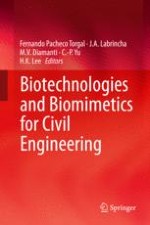2015 | OriginalPaper | Chapter
16. A Case Study: Bacterial Surface Treatment of Normal and Lightweight Concrete
Authors : H. K. Kim, H. K. Lee
Published in: Biotechnologies and Biomimetics for Civil Engineering
Publisher: Springer International Publishing
Activate our intelligent search to find suitable subject content or patents.
Select sections of text to find matching patents with Artificial Intelligence. powered by
Select sections of text to find additional relevant content using AI-assisted search. powered by
